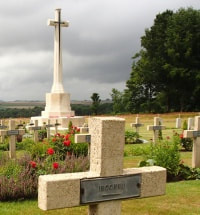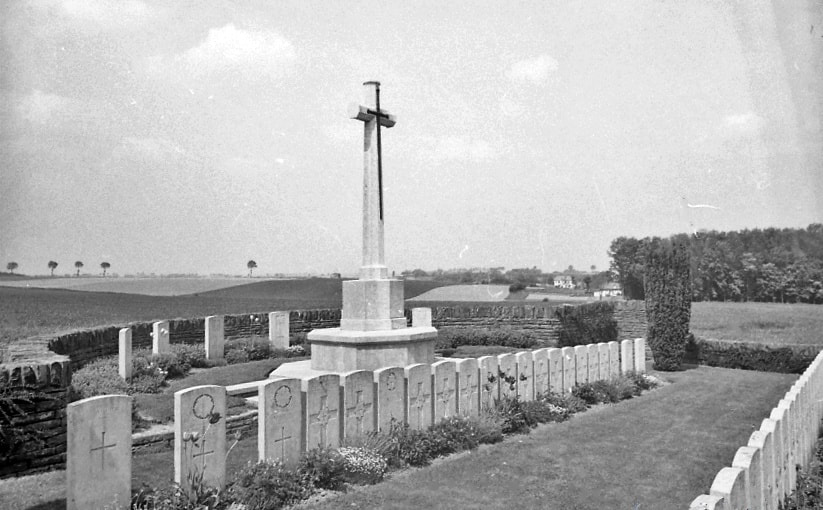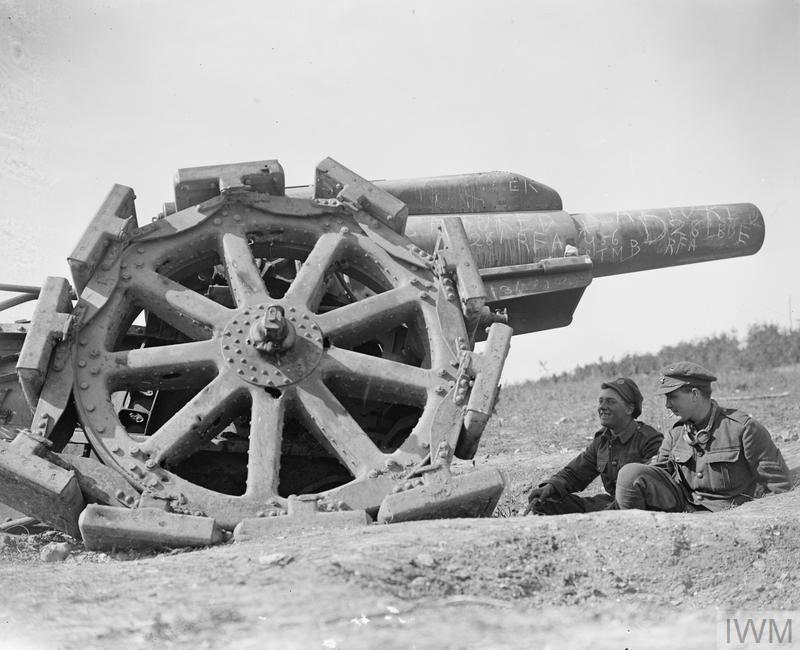MORY STREET MILITARY CEMETERY
St. Léger
Pas De Calais
France
GPS Coordinates - Latitude: 50.18093, Longitude: 2.86169
Location Information
St Léger is is between Arras and Bapaume. The Cemetery is at the south end of the village on the road to Mory, the D36E.
Visiting Information
The location or design of this site make wheelchair access impossible.
Historical Information
Mory and St. Léger were occupied by Commonwealth troops in the middle of March 1917. They were lost after obstinate defence by the 40th and 34th Divisions a year after and recaptured towards the end of the following August, after severe fighting, by the 62nd (West Riding) and Guards Division.
The first Commonwealth burials were made in Mory Street Military Cemetery in 1917. The cemetery was once considerably larger, but 48 German and certain French graves were later removed.
The cemetery now contains 66 Commonwealth burials and commemorations of the First World War. Five of the burials are unidentified and six graves graves destroyed by shell fire or removed after the Armistice are now represented by special memorials.
Total Burials: 66.
Identified Casualties: United Kingdom 61.
Unidentified Casualties: United Kingdom 5.
The cemetery was designed by William Harrison Cowlishaw
St Léger is is between Arras and Bapaume. The Cemetery is at the south end of the village on the road to Mory, the D36E.
Visiting Information
The location or design of this site make wheelchair access impossible.
Historical Information
Mory and St. Léger were occupied by Commonwealth troops in the middle of March 1917. They were lost after obstinate defence by the 40th and 34th Divisions a year after and recaptured towards the end of the following August, after severe fighting, by the 62nd (West Riding) and Guards Division.
The first Commonwealth burials were made in Mory Street Military Cemetery in 1917. The cemetery was once considerably larger, but 48 German and certain French graves were later removed.
The cemetery now contains 66 Commonwealth burials and commemorations of the First World War. Five of the burials are unidentified and six graves graves destroyed by shell fire or removed after the Armistice are now represented by special memorials.
Total Burials: 66.
Identified Casualties: United Kingdom 61.
Unidentified Casualties: United Kingdom 5.
The cemetery was designed by William Harrison Cowlishaw

Second Lieutenant
Gerard Charles Brassey
2nd Bn. Coldstream Guards
27th August 1918, aged 19.
Plot A. 4.
Gerard Charles Brassey was born on the 28th December 1898. He was the second son of Sir Leonard Brassey, 1st Bart., M.P., and Lady Violet Brassey, of Apethorpe Hall, Peterborough. He had 4 brothers and one sister.
Gerard was educated at Wellington House, Westgate-on-Sea before going on to Eton College where he became Captain of the Oppidans. (Oppidans is a term used to refer to the majority of boys at Eton who are common entrants as opposed to the much smaller group of King's Scholars) Gerard left Eton in July 1917 to join the Coldstream Guards.
By the 25th August 1918, the 2nd Battalion were part of the Guards Division on front line trench duty at St Léger about three miles north of Bapaume. At 0700 on 27th August an attack was launched. The enemy were expecting it and immediately opened very heavy fire on the Coldstream Guards from the village of Croisilles. One company reached the final objective, but without sufficient support they had to withdraw. German machine-guns under cover of their trenches, swept the ground and brought the attack to a standstill. The losses in the Battalion were 3 officers killed in action, 7 officers wounded and 111 other ranks killed in action, 192 wounded.
Gerard was one of those officers killed. He had only been at the front since March of that year. His uncle, Lieutenant Colonel Edwin Brassey was Commander of the 2nd Battalion at the time of his nephew's death.
Gerard Charles Brassey
2nd Bn. Coldstream Guards
27th August 1918, aged 19.
Plot A. 4.
Gerard Charles Brassey was born on the 28th December 1898. He was the second son of Sir Leonard Brassey, 1st Bart., M.P., and Lady Violet Brassey, of Apethorpe Hall, Peterborough. He had 4 brothers and one sister.
Gerard was educated at Wellington House, Westgate-on-Sea before going on to Eton College where he became Captain of the Oppidans. (Oppidans is a term used to refer to the majority of boys at Eton who are common entrants as opposed to the much smaller group of King's Scholars) Gerard left Eton in July 1917 to join the Coldstream Guards.
By the 25th August 1918, the 2nd Battalion were part of the Guards Division on front line trench duty at St Léger about three miles north of Bapaume. At 0700 on 27th August an attack was launched. The enemy were expecting it and immediately opened very heavy fire on the Coldstream Guards from the village of Croisilles. One company reached the final objective, but without sufficient support they had to withdraw. German machine-guns under cover of their trenches, swept the ground and brought the attack to a standstill. The losses in the Battalion were 3 officers killed in action, 7 officers wounded and 111 other ranks killed in action, 192 wounded.
Gerard was one of those officers killed. He had only been at the front since March of that year. His uncle, Lieutenant Colonel Edwin Brassey was Commander of the 2nd Battalion at the time of his nephew's death.

15943 Lance Corporal
Thomas Edward Clifford, M. M.
2nd Bn. Coldstream Guards
27th August 1918, aged 25.
Row B. 9.
Thomas Edward Clifford, M. M.
2nd Bn. Coldstream Guards
27th August 1918, aged 25.
Row B. 9.

Lieutenant
Frederick Beckham Handley, M. C. & Bar, Mentioned in Despatches
No. 3 Company, 2nd Bn. Coldstream Guards
27th August 1918, aged 35.
Row. A. 3.
Son of Francis F. and Ada Handley, of Handley Cross, Albert Rd., Cheltenham.
Frederick Beckham Handley, M. C. & Bar, Mentioned in Despatches
No. 3 Company, 2nd Bn. Coldstream Guards
27th August 1918, aged 35.
Row. A. 3.
Son of Francis F. and Ada Handley, of Handley Cross, Albert Rd., Cheltenham.

13761 Private
Thomas William Edward Yates
2nd Bn. Coldstream Guards
28th August 1918, aged 30.
Row. B. 1.
Thomas was the son of John George Yates and wife Annie Maria. By 1901 Thomas had 3 younger siblings: Herbert Yates 1890, Stephen Frank Yates 1894-2nd November, 1918 (also died in the war and buried in St. Sever Cemetery Extension,) and Alice Ann Lily Yates 1900-1903. The 1911 Census showed that John & Annie had had a total of 8 children, 4 of whom had died.
In 1910 Thomas married Annie Elliott, and he worked as a miner in the Gawthorpe Pit; he enlisted in November 1914. He was survived by wife Annie and 1 child (possibly named Violet Yates).
Thomas William Edward Yates
2nd Bn. Coldstream Guards
28th August 1918, aged 30.
Row. B. 1.
Thomas was the son of John George Yates and wife Annie Maria. By 1901 Thomas had 3 younger siblings: Herbert Yates 1890, Stephen Frank Yates 1894-2nd November, 1918 (also died in the war and buried in St. Sever Cemetery Extension,) and Alice Ann Lily Yates 1900-1903. The 1911 Census showed that John & Annie had had a total of 8 children, 4 of whom had died.
In 1910 Thomas married Annie Elliott, and he worked as a miner in the Gawthorpe Pit; he enlisted in November 1914. He was survived by wife Annie and 1 child (possibly named Violet Yates).
Images in gallery below © Johan Pauwels
Other cemeteries within 2 miles radius:

St. Léger British Cemetery (0.6m)
L' Homme Mort British Cemetery (1.1m)
Croisilles British Cemetery (1.2m)
Mory Abbey Military Cemetery (1.5m)
Croisilles Railway Cemetery (1.5m)
Écoust St.-Mein British Cemetery (2.0m)
H.A.C. (Honourable Artillery Company) Cemetery (2.0m)
L' Homme Mort British Cemetery (1.1m)
Croisilles British Cemetery (1.2m)
Mory Abbey Military Cemetery (1.5m)
Croisilles Railway Cemetery (1.5m)
Écoust St.-Mein British Cemetery (2.0m)
H.A.C. (Honourable Artillery Company) Cemetery (2.0m)
































